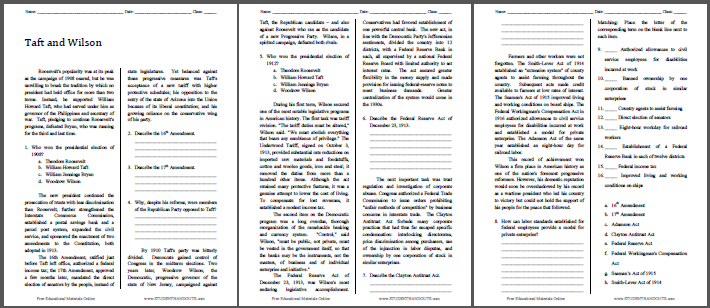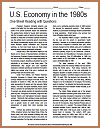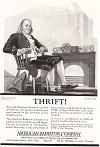Taft and Wilson |
 Roosevelt's popularity was at its peak as the campaign of
1908 neared, but he was unwilling to break the tradition by
which no president had held office for more than two terms.
Instead, he supported William Howard Taft, who had served under
him as governor of the Philippines and secretary of war.
Taft, pledging to continue Roosevelt's programs, defeated Bryan,
who was running for the third and last time. Roosevelt's popularity was at its peak as the campaign of
1908 neared, but he was unwilling to break the tradition by
which no president had held office for more than two terms.
Instead, he supported William Howard Taft, who had served under
him as governor of the Philippines and secretary of war.
Taft, pledging to continue Roosevelt's programs, defeated Bryan,
who was running for the third and last time.The new president continued the prosecution of trusts with
less discrimination than Roosevelt, further strengthened the
Interstate Commerce Commission, established a postal savings
bank and a parcel post system, expanded the civil service, and
sponsored the enactment of two amendments to the Constitution,
both adopted in 1913. The 16th Amendment, ratified just before Taft left office, authorized a federal income tax; the 17th Amendment, approved a few months later, mandated the direct election of senators by the people, instead of state legislatures. Yet balanced against these progressive measures was Taft's acceptance of a new tariff with higher protective schedules; his opposition to the entry of the state of Arizona into the Union because of its liberal constitution; and his growing reliance on the conservative wing of his party. By 1910 Taft's party was bitterly divided. Democrats gained control of Congress in the midterm elections. Two years later, Woodrow Wilson, the Democratic, progressive governor of the state of New Jersey, campaigned against Taft, the Republican candidate – and also against Roosevelt who ran as the candidate of a new Progressive Party. Wilson, in a spirited campaign, defeated both rivals. During his first term, Wilson secured one of the most notable legislative programs in American history. The first task was tariff revision. "The tariff duties must be altered," Wilson said. "We must abolish everything that bears any semblance of privilege." The Underwood Tariff, signed on October 3, 1913, provided substantial rate reductions on imported raw materials and foodstuffs, cotton and woolen goods, iron and steel; it removed the duties from more than a hundred other items. Although the act retained many protective features, it was a genuine attempt to lower the cost of living. To compensate for lost revenues, it established a modest income tax. The second item on the Democratic program was a long overdue, thorough reorganization of the ramshackle banking and currency system. "Control," said Wilson, "must be public, not private, must be vested in the government itself, so that the banks may be the instruments, not the masters, of business and of individual enterprise and initiative." The Federal Reserve Act of December 23, 1913, was Wilson's most enduring legislative accomplishment. Conservatives had favored establishment of one powerful central bank. The new act, in line with the Democratic Party's Jeffersonian sentiments, divided the country into 12 districts, with a Federal Reserve Bank in each, all supervised by a national Federal Reserve Board with limited authority to set interest rates. The act assured greater flexibility in the money supply and made provision for issuing federal-reserve notes to meet business demands. Greater centralization of the system would come in the 1930s. The next important task was trust regulation and investigation of corporate abuses. Congress authorized a Federal Trade Commission to issue orders prohibiting "unfair methods of competition" by business concerns in interstate trade. The Clayton Antitrust Act forbade many corporate practices that had thus far escaped specific condemnation: interlocking directorates, price discrimination among purchasers, use of the injunction in labor disputes, and ownership by one corporation of stock in similar enterprises. Farmers and other workers were not forgotten. The Smith-Lever
Act of 1914 established an "extension system" of county agents
to assist farming throughout the country. Subsequent acts
made credit available to farmers at low rates of interest. The
Seamen's Act of 1915 improved living and working conditions on
board ships. The Federal Workingman's Compensation Act in 1916
authorized allowances to civil service employees for
disabilities incurred at work and established a model for
private enterprise. The Adamson Act of the same year established
an eight-hour day for railroad labor. This record of achievement won Wilson a firm place in American history as one of the nation's foremost progressive reformers. However, his domestic reputation would soon be overshadowed by his record as a wartime president who led his country to victory but could not hold the support of his people for the peace that followed. |
Click here to print. Answer Key: (1) B - William Howard Taft; (2) federal income tax; (3) direct election of senators; (4) Taft's acceptance of a new tariff with higher protective schedules; his opposition to the entry of the state of Arizona into the Union because of its liberal constitution; and his growing reliance on the conservative wing of his party; (5) D - Woodrow Wilson; (6) divided the country into 12 districts, with a Federal Reserve Bank in each, all supervised by a national Federal Reserve Board with limited authority to set interest rates; assured greater flexibility in the money supply and made provision for issuing federal-reserve notes to meet business demands; (7) forbade interlocking directorates, price discrimination among purchasers, use of the injunction in labor disputes, and ownership by one corporation of stock in similar enterprises; (8) Answers will vary; (9) F - Federal Workingman's Compensation Act; (10) D - Clayton Antitrust Act; (11) H - Smith-Lever Act; (12) B - 17th Amendment; (13) C - Adamson Act; (14) E - Federal Reserve Act; (15) A - 16th Amendment; (16) G - Seaman's Act. |
 |
|---|
Text courtesy of the U.S. State Department,
Bureau of International Information Programs, 2005 |











